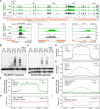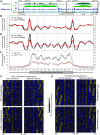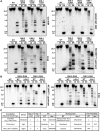Nucleosome Positioning by an Evolutionarily Conserved Chromatin Remodeler Prevents Aberrant DNA Methylation in Neurospora
- PMID: 30554169
- PMCID: PMC6366918
- DOI: 10.1534/genetics.118.301711
Nucleosome Positioning by an Evolutionarily Conserved Chromatin Remodeler Prevents Aberrant DNA Methylation in Neurospora
Abstract
In the filamentous fungus Neurospora crassa, constitutive heterochromatin is marked by tri-methylation of histone H3 lysine 9 (H3K9me3) and DNA methylation. We identified mutations in the Neurospora defective in methylation-1 (dim-1) gene that cause defects in cytosine methylation and implicate a putative AAA-ATPase chromatin remodeler. Although it was well-established that chromatin remodelers can affect transcription by influencing DNA accessibility with nucleosomes, little was known about the role of remodelers on chromatin that is normally not transcribed, including regions of constitutive heterochromatin. We found that dim-1 mutants display both reduced DNA methylation in heterochromatic regions as well as increased DNA methylation and H3K9me3 in some intergenic regions associated with highly expressed genes. Deletion of dim-1 leads to atypically spaced nucleosomes throughout the genome and numerous changes in gene expression. DIM-1 localizes to both heterochromatin and intergenic regions that become hyper-methylated in dim-1 strains. Our findings indicate that DIM-1 normally positions nucleosomes in both heterochromatin and euchromatin and that the standard arrangement and density of nucleosomes is required for the proper function of heterochromatin machinery.
Keywords: CATP; DIM-1; DNA methylation; Neurospora crassa; heterochromatin; nucleosome.
Copyright © 2019 by the Genetics Society of America.
Figures






Similar articles
-
Induction of H3K9me3 and DNA methylation by tethered heterochromatin factors in Neurospora crassa.Proc Natl Acad Sci U S A. 2017 Nov 7;114(45):E9598-E9607. doi: 10.1073/pnas.1715049114. Epub 2017 Oct 23. Proc Natl Acad Sci U S A. 2017. PMID: 29078403 Free PMC article.
-
Histone H3 lysine 4 methyltransferase is required for facultative heterochromatin at specific loci.BMC Genomics. 2019 May 8;20(1):350. doi: 10.1186/s12864-019-5729-7. BMC Genomics. 2019. PMID: 31068130 Free PMC article.
-
Identification of DIM-7, a protein required to target the DIM-5 H3 methyltransferase to chromatin.Proc Natl Acad Sci U S A. 2010 May 4;107(18):8310-5. doi: 10.1073/pnas.1000328107. Epub 2010 Apr 19. Proc Natl Acad Sci U S A. 2010. PMID: 20404183 Free PMC article.
-
DNA methylation and the formation of heterochromatin in Neurospora crassa.Heredity (Edinb). 2010 Jul;105(1):38-44. doi: 10.1038/hdy.2010.44. Epub 2010 Apr 21. Heredity (Edinb). 2010. PMID: 20407471 Review.
-
Molecular Regulation of Circadian Chromatin.J Mol Biol. 2020 May 29;432(12):3466-3482. doi: 10.1016/j.jmb.2020.01.009. Epub 2020 Jan 16. J Mol Biol. 2020. PMID: 31954735 Review.
Cited by
-
A constitutive heterochromatic region shapes genome organization and impacts gene expression in Neurospora crassa.BMC Genomics. 2024 Dec 20;25(1):1215. doi: 10.1186/s12864-024-11110-7. BMC Genomics. 2024. PMID: 39701998 Free PMC article.
-
ASH1-catalyzed H3K36 methylation drives gene repression and marks H3K27me2/3-competent chromatin.Elife. 2018 Nov 23;7:e41497. doi: 10.7554/eLife.41497. Elife. 2018. PMID: 30468429 Free PMC article.
-
A Constitutive Heterochromatic Region Shapes Genome Organization and Impacts Gene Expression in Neurospora crassa.bioRxiv [Preprint]. 2024 Oct 14:2024.06.07.597955. doi: 10.1101/2024.06.07.597955. bioRxiv. 2024. Update in: BMC Genomics. 2024 Dec 20;25(1):1215. doi: 10.1186/s12864-024-11110-7. PMID: 39229016 Free PMC article. Updated. Preprint.
-
Rapid and inexpensive preparation of genome-wide nucleosome footprints from model and non-model organisms.STAR Protoc. 2021 May 18;2(2):100486. doi: 10.1016/j.xpro.2021.100486. eCollection 2021 Jun 18. STAR Protoc. 2021. PMID: 34041500 Free PMC article.
-
Experimental evidence for the functional importance and adaptive advantage of A-to-I RNA editing in fungi.Proc Natl Acad Sci U S A. 2023 Mar 21;120(12):e2219029120. doi: 10.1073/pnas.2219029120. Epub 2023 Mar 14. Proc Natl Acad Sci U S A. 2023. PMID: 36917661 Free PMC article.
References
Publication types
MeSH terms
Substances
Associated data
Grants and funding
LinkOut - more resources
Full Text Sources
Other Literature Sources
Molecular Biology Databases

